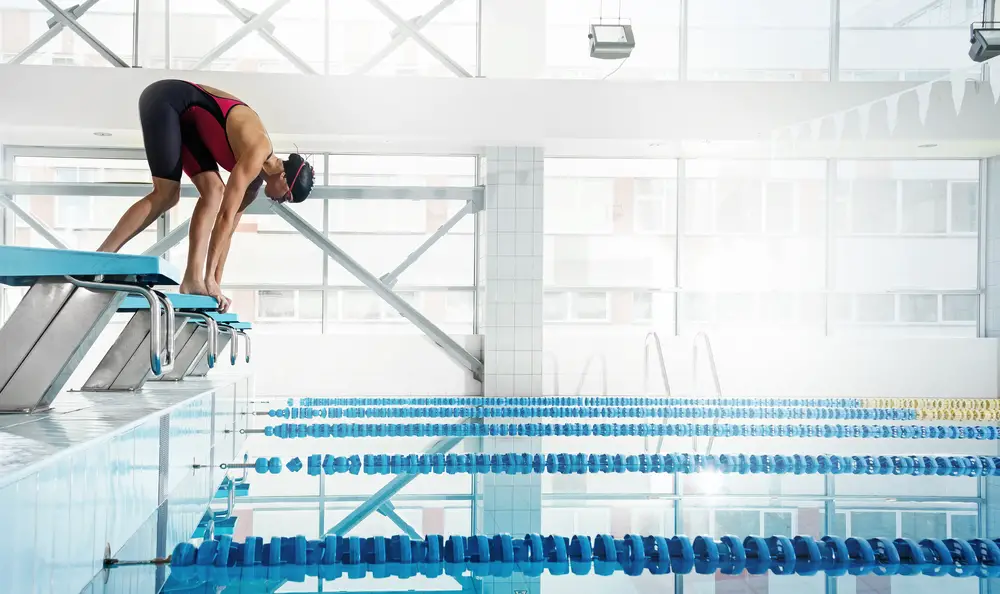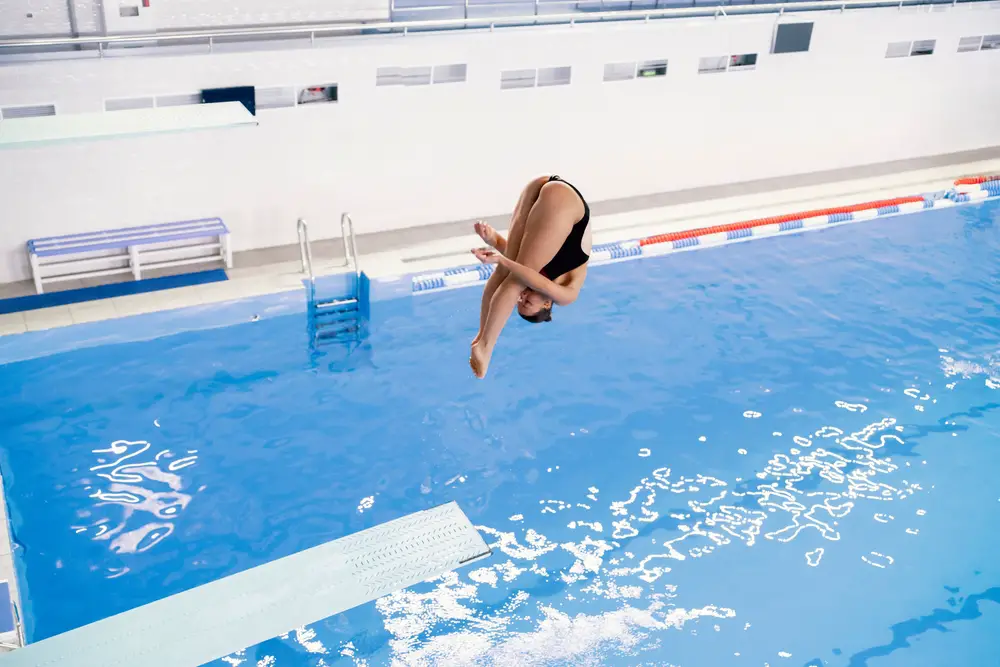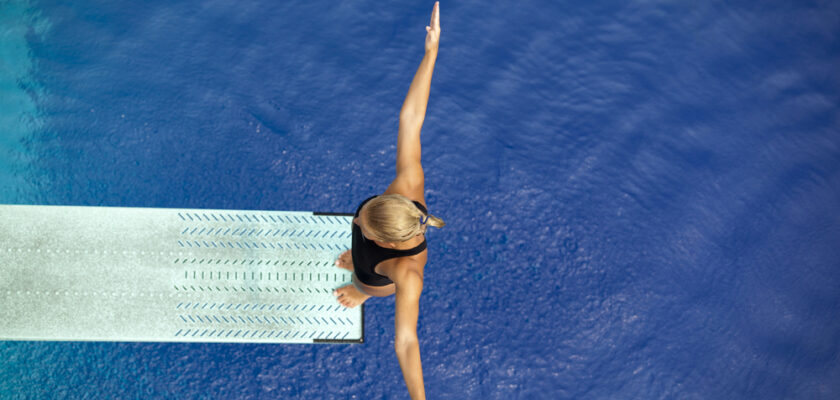The diving is an aquatic sport that combines gymnastics with precise jumping techniques. Athletes perform jumps that must be pleasing to the eye and full of technique. It is practiced on platforms and trampolines, where the jumps take place, and the athletes fall into a deep pool.
For athletes in the sport, knowing how to master the different types and techniques of jumping can be the key to achieving a breathtaking performance. To help you understand the sport better, we’ve created the glossary of diving!
With this list, you’ll get to know how the diving work, as you’ll get to know the main terms used by practitioners.
We’re going to explain what each of them means, making you understand the importance of this knowledge for good diving practice.
Check out the sport’s main terms in the glossary of diving!

Open your Betano account and get up to 1,000 reais in bonuses.
Payments via PIX, live games and super odds!
Click here to open your account!
Glossary of diving: complete list
Check out the terms that will be covered in the show jumping glossary!
- Abduction
- Entry angle
- Approach
- Armstand
- Start
- Assunção
- Balance
- Belly down
- Belly up
- Coefficient of difficulty (CD)
- Take-off
- Entry
- Flic-Flac
- Float
- Drawer
- Grouped
- Knee extended
- Crank
- Step
- Pirouette
- Platform
- Scoring
- Free position
- Carpado position
- Reverse
- Rolling
- Jumping sequence
- Trampoline
- Tufted
- Turned
Glossary of show jumping: get to know the terms
Abduction
In show jumping, abduction is the movement of moving a part of the body away from the median plane, such as spreading the arms out to the sides during a jump.
Entry angle
The entry angle is the angle at which the jumper enters the water perpendicular to the surface, thus minimizing splashes.
Approach
The approach, in show jumping, is the initial run that the jumper makes on the platform or trampoline before executing the jump, which is also important.
Armstand
Armstand, or handstand, is the position in which the jumper stands upside down, balancing on their hands before starting the jump.
Push-off
The initial movement of the jump from the edge of the trampoline or platform is called the pull and is very crucial for generating height and rotation at the moment of jumping.
Assumption
The phase in which the jumper adopts the starting position after take-off, preparing to perform the spins and pirouettes, is called the assumption.
Swing
The preparation movement on the trampoline is called a swing in show jumping. It happens when the jumper swings to create momentum before jumping.
Belly down
Belly down is a jumping starting position that happens when the jumper is facing the pool.
Belly up
The belly-up is the initial jumping position in which the jumper stands with his back to the water.
Coefficient of difficulty
The coefficient of difficulty is the numerical value that represents the complexity of an ornamental jump, taking into account the number of rotations, pirouettes and the height of the jump.
Take-off
The moment when the jumper leaves the surface of the trampoline or platform is called take-off in show jumping.
Entry
The entry is the moment when the jumper enters the water and ideally there should be as little splashing as possible.
Flic-Flac
The flic-flac is a jump performed backwards on a trampoline, usually used as a preparatory movement.
Float
The phase of the jump in which the jumper’s body is in the air is buoyancy and takes place after take-off and before entering the water.
Drawer
Drawer is a vaulting position in which the legs are together and the knees are bent.
Grouped
A position in show jumping in which the jumper keeps their knees bent and close to their chest.
Extended knee
The extended knee is a position in which the knees are fully extended, usually when entering the water.
Crank
Cranking is the longitudinal rotation of the body during the jump, while the athlete is performing horizontal spins.
Stride
The stride is the set of steps executed in the approach before the jump.
Pirouette
The rotation of the body around the vertical axis during the jump is called a pirouette.
Platform
The elevated structure from which the jumps are made is called a platform, and has common heights of 5, 7.5 and 10 meters.
Scoring
The judges’ evaluation of the jump is the score. It is based on execution, difficulty and entry into the water.
Free position
A jumping position in which the jumper is free to use combinations of legs and arms, such as grouped, extended or carpado, is called a free position.
Carpado position
Carpado is a jumping position in which the body is bent at the waist, with legs extended and hands holding the ankles.
Revirado
Revirado, on the other hand, is a jumping category in which the athlete jumps facing the platform but rotates backwards.
Rolling
Rolling is the movement in which the jumper makes a complete rotation around the horizontal axis of the body.
Jump sequence
A jump sequence is a series of planned jumps that a jumper performs in a competition.
Trampoline
A trampoline is a flexible, elastic surface used for jumping, usually located one to three meters above the water.
Tufted
Tufted is a position in which the body is bent at the waist and the knees are pulled towards the chest.
Flip
The flip is a type of jump in which the jumper performs a complete rotation in the air before entering the water headfirst.

Glossary of show jumping: complete list
- Abduction
- Entry angle
- Approach
- Armstand
- Start
- Assunção
- Balance
- Belly down
- Belly up
- Coefficient of difficulty (CD)
- Take-off
- Entry
- Flic-Flac
- Float
- Drawer
- Grouped
- Knee extended
- Crank
- Step
- Pirouette
- Platform
- Scoring
- Free position
- Carpado position
- Reverse
- Rolling
- Jumping sequence
- Trampoline
- Tufted
- Turned
Glossary of diving
If you enjoyed learning about the terms in the glossary of diving, take the opportunity to continue browsing the site and check out more content on this and many other sports.
Here, you can find out all about the sports world and keep up to date with the latest news! Don’t forget to leave your comment below!



